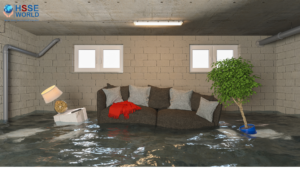The Common Industrial Fire Hazards and Prevention
4 min readAccording to the NFPA, from 2011 to 2015 there were an estimated 37,910 fires in industrial and manufacturing properties causing an estimated $1.2 billion in property damage per year. That is an astounding cost.
The leading causes of these industrial fires were:
- Electrical distribution and lighting equipment (24%)
- Heating equipment (16%)
- Intentional fires (9%)
According to the NFPA, fires caused by electrical distribution and lighting equipment accounted for 55% of direct property damage and 9% of injuries in structure fires.

Other leading causes included:
- Cooking equipment (4%)
- Torch, burner, and soldering iron (4%)
- Exposure fires (4%)
In this article, we’ll look at five hazards that can lead to industrial fires. By knowing the causes of these fires and what we can do to prevent them, we can lower the risk of damaging, injurious, and possibly fires.
Flammable Gasses and Liquids
Flammable gas and liquid fires can be disastrous, but they can also be prevented by following some simple steps.
First, consult the safety data sheet for each flammable gas and liquid on the premises so that you’re aware of the hazards you’re dealing with.
Consult OSHA regulations and the Combustible Liquid Code to help you learn how to safely store flammable liquids.
Along with proper storage, it is crucial to control all ignition sources. You will want to store fuels a safe distance away from oxidizers. Having adequate procedures in place, providing training, and monitoring compliance on the handling of flammable gases and liquids is essential to prevent potential fires and explosions since many incidents are directly related to human error or failure to follow established procedures.
Electrical Malfunctions
Electrical fires or malfunctions were a factor in 20% of structure fires and are one of the most common types of fire in the workplace.
Regularly inspecting and maintaining electrical equipment is crucial to preventing electrical fires. Look for damaged cabling, loose cables, and damaged grounds. Replace or disconnect any faulty equipment.
Ensure wiring is up to code, don’t overload circuits chords or outlets, and inspect extension chords. Unplugging temporary electrical equipment when not in use, employing regular housekeeping procedures, and implementing a reporting system can all help prevent electrical fires
The NFPA has a family of codes and standards that deal with electrical issues – including:
- NFPA 70, National Electrical Code (NEC)
- NFPA 70B, Recommended Practice for Electrical Equipment Maintenance
- NFPA 70E, Standard for Electrical Safety in the Workplace
Combustible Dusts
Combustible dusts are an often-overlooked fire hazard that affects many industries such as the chemical industries, wood working, metal working, plastics, agricultural, coal mining, and food production. Many companies are not even aware of the hazards of combustible dusts.
Dust explosions occur due to the rapid combustion of dust in an enclosed location. The consequences can be serious – on February 7, 2008, a combustible dust explosion in a refined sugar silo at the Imperial Sugar company in Georgia killed 14 people and injured 36 others.
Controlling dust is critical to preventing dust explosions. Control methods include:
- Wetting down the dust
- Housekeeping to prevent dust from accumulating
- Isolation
- Bonding or grounding
- Adequate ventilation and filtration
- Dust collection (wet dust collection or with specialized equipment like wet filtered down draft tables)
Other steps you should take include:
- Using hazard-classified vacuums, sweepers and electrical cleaning equipment
- Banning smoking in combustible areas
- Only allowing hot work in designated areas
- Providing training
- Having and ensuring compliance with procedures
See NFPA 61, Standard for the Prevention of Fires and Dust Explosions in Agricultural and Food Processing Facilities for more details.
Hot Work
Early in my safety career, a company I worked with were outfitting a vessel for an expedition to develop a 3D map the debris field of the Titanic. The work included welding equipment to the deck. An agreement was made for the vessel to provide a fire watch. During the work, a fire broke out in the cargo hold resulting in evacuation and minor damage. Thanks to proper preparation, no one was hurt and the expedition remained on schedule.
To prevent fires due to hot work and combustibles, it is best to remove all combustibles from possible sources of ignition and structures.
Ensure there is an adequate fire extinguisher on hand, cover combustible areas with fire blankets, have an effective hot work procedure, and ensure everyone knows their roles and responsibilities.
A risk assessment is an essential tool to help recognize the hazards and clearly communicate the controls required.
Equipment and Machines
Following the maintenance procedures recommended by the manufacturer is crucial to preventing potential equipment and machine fires, as well as immediately repairing any issues which may occur.
Keep the equipment clean of greases and oils, as these pose a major fire risk.
Keep electrical equipment dry and implement adequate housekeeping of equipment and the areas immediately around it to make sure they are kept clean.
Train your people on the proper use and maintenance of equipment and ensure you have a regularly scheduled maintenance program.
Preventing equipment from overheating will also reduce the risk.




1 thought on “The Common Industrial Fire Hazards and Prevention”